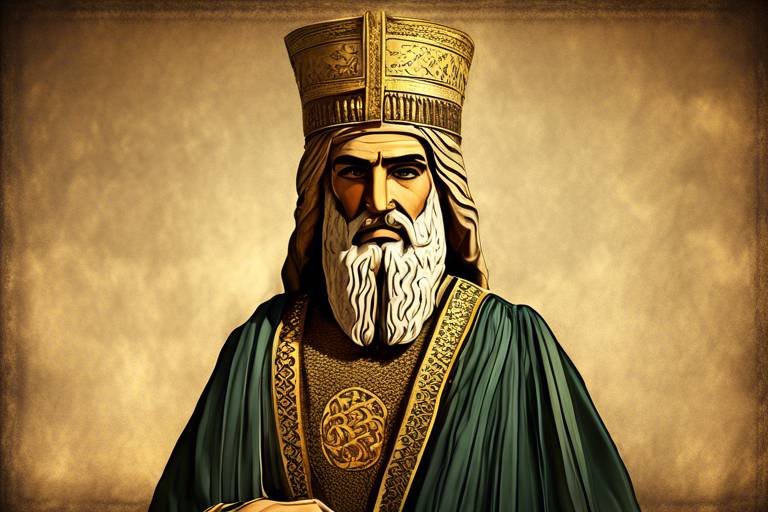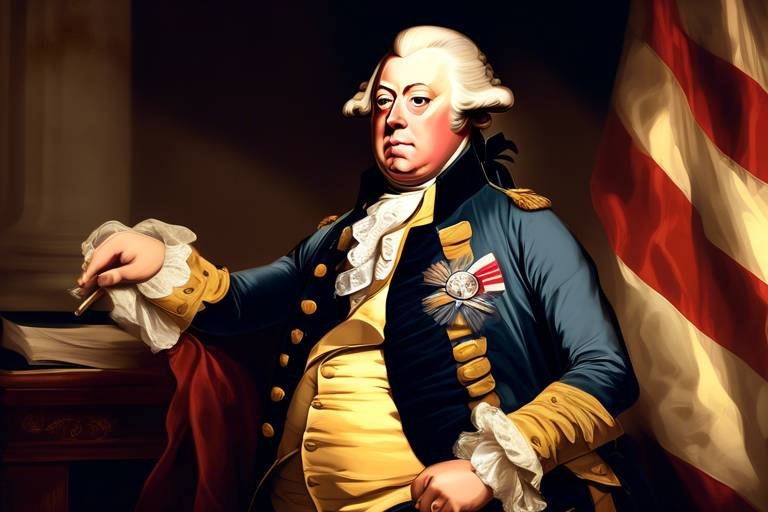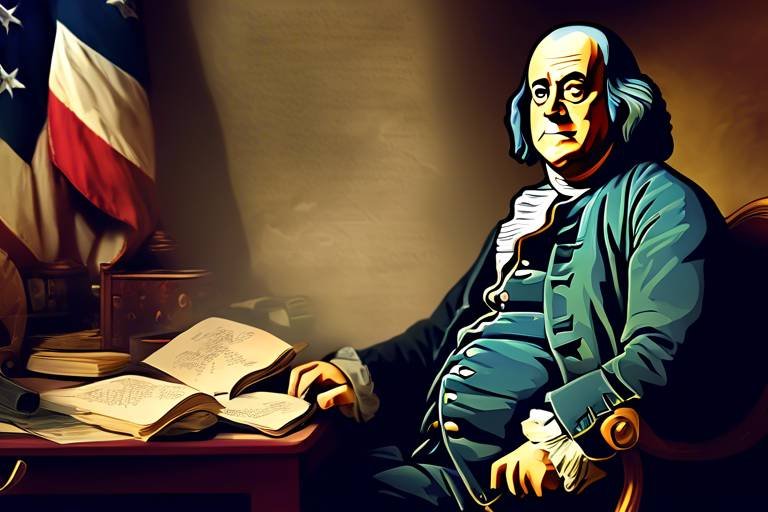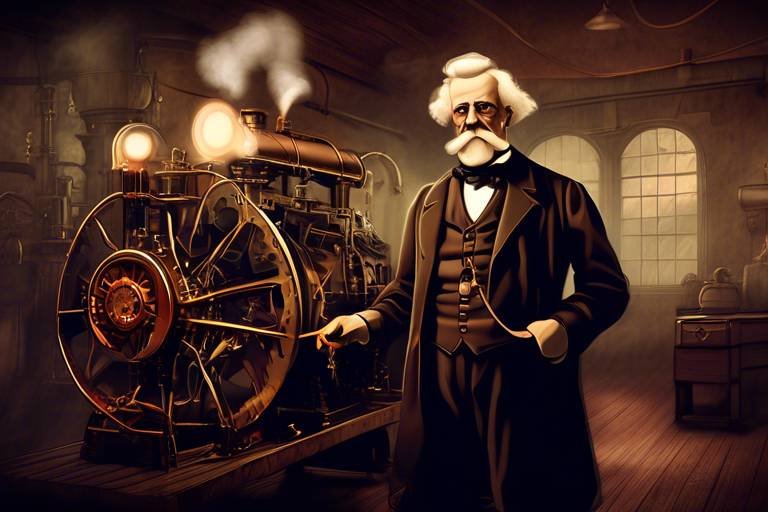William the Conqueror: The Norman Invader
William the Conqueror, also known as William I of England, was a formidable figure in medieval history who reshaped the landscape of England through his conquests. Born in 1028 in Falaise, Normandy, William ascended to power as the Duke of Normandy at a young age, facing numerous challenges to solidify his rule over the region.
His claim to the English throne was rooted in a complex web of alliances, rivalries, and ambitions, culminating in the famous Battle of Hastings in 1066. This pivotal event marked the beginning of Norman rule in England and established William as a powerful monarch with a lasting impact on English history.
William's conquest of England was not merely a military victory; it was a cultural and political transformation that introduced feudalism to the English society. The Domesday Book, a comprehensive survey of landownership and resources, was commissioned by William to assert his control over the newly conquered territory and establish a system of governance.
The Norman influence on English culture, language, and governance was profound, shaping the development of the English nation for centuries to come. The feudal system implemented by William redefined the social structure of England, consolidating power in the hands of the nobility and laying the foundation for medieval governance.
One of the enduring legacies of William the Conqueror is his impact on the English language. The Norman invasion brought a wave of French vocabulary into the English lexicon, enriching the language and reflecting the cultural exchange between the Normans and the Anglo-Saxons.
Historical accounts of William's reign offer a complex tapestry of interpretations, with scholars debating the nature of his rule, his motivations, and his legacy. The historiography of William the Conqueror continues to be a subject of scholarly inquiry, shedding light on the intricacies of medieval politics and power dynamics.
In conclusion, William the Conqueror stands as a towering figure in English history, whose conquests and legacy continue to shape the narrative of the medieval period. His reign marked a turning point in English history, ushering in a new era of Norman influence and cultural exchange that left an indelible mark on the nation.

Early Life and Rise to Power
William the Conqueror, born in 1028 in Falaise, Normandy, faced a tumultuous childhood marked by political intrigue and power struggles. As the illegitimate son of Duke Robert I of Normandy, William's claim to the duchy was contested by various factions upon his father's death. Despite these challenges, William's tenacity and strategic acumen allowed him to assert his authority and ascend to the position of Duke of Normandy at a young age.
With Normandy under his control, William embarked on a mission to solidify his power and expand his influence in France. Through a combination of military prowess and shrewd diplomacy, he successfully navigated the complex web of feudal relationships that defined medieval Europe. By forging alliances with key nobles and suppressing internal rebellions, William established himself as a formidable ruler capable of uniting disparate factions under his banner.
William's rise to power was not without its obstacles, as rival claimants and external threats constantly tested his leadership. However, his unwavering determination and strategic vision enabled him to overcome these challenges and emerge as a dominant force in Norman politics. Through a series of military campaigns and political maneuvers, William solidified his position as the undisputed Duke of Normandy, laying the foundation for his future conquest of England.

Conquest of England
William the Conqueror's conquest of England marked a pivotal moment in history, forever altering the course of the English monarchy. The events leading up to the Battle of Hastings were fraught with political intrigue and military strategy, as William set his sights on claiming the English throne. With a formidable army and a fierce determination, William embarked on a campaign that would culminate in one of the most significant battles in English history.
Employing innovative tactics and leveraging his military prowess, William faced off against the English forces led by King Harold II at the Battle of Hastings. The clash of armies on the battlefield was intense, with both sides fighting fiercely for control. The turning point came with the death of King Harold II, a moment that sealed William's victory and secured his claim to the English crown.
The aftermath of the conquest saw William consolidating his power through the establishment of Norman rule in England. He implemented sweeping changes, including the introduction of feudalism, to solidify his control over the newly conquered territory. The Domesday Book, a comprehensive survey of landholdings and resources, was commissioned to aid in the administration of the kingdom and assert William's authority.
The Norman influence on English culture was profound, shaping the language, architecture, and governance of the land. The blending of Norman and Anglo-Saxon traditions created a rich tapestry of influences that would define the future of England. William's conquest not only reshaped the political landscape but also laid the foundation for a new era of English history.

Norman Rule in England
The Norman Rule in England marks a significant period in English history following William the Conqueror's successful invasion in 1066. William's rule brought about profound changes in governance, society, and culture, shaping the future of England for centuries to come. One of the most impactful legacies of the Norman Rule was the establishment of feudalism, a hierarchical system of land ownership and loyalty that structured English society. Through the implementation of feudalism, William centralized power in his hands, distributing land to his loyal followers in exchange for military service and allegiance.
Additionally, William commissioned the Domesday Book, a comprehensive survey of landholdings and resources in England, which provided valuable insights into the economic and social landscape of the country. This meticulous record-keeping allowed William to assert control over his new territory and ensure efficient taxation and governance. The Domesday Book remains a vital historical document, offering a glimpse into the intricacies of medieval English society under Norman rule.
Furthermore, the Norman influence on English culture was profound, introducing a rich tapestry of French vocabulary, customs, and traditions that blended with the existing Anglo-Saxon heritage. This cultural exchange enriched the English language, giving rise to a unique linguistic fusion that continues to shape modern English. The Normans also left their mark on architecture, art, and governance, contributing to the vibrant tapestry of English heritage that we see today.
Overall, the Norman Rule in England under William the Conqueror ushered in a new era of governance and cultural exchange that laid the foundation for the development of England as a nation. The enduring impact of William's rule can be seen in the institutions, language, and traditions that continue to define English identity to this day.

Legacy of William the Conqueror
William the Conqueror left a lasting legacy that shaped the course of English history for centuries to come. His conquest of England in 1066 not only altered the political landscape but also introduced significant changes to English society and culture.
One of William's most enduring legacies is the establishment of feudalism in England. By redistributing land to his loyal supporters and creating a hierarchical system of land ownership, William solidified his control over the newly conquered territory. This system of governance laid the foundation for centuries of social structure and land tenure in England.
Furthermore, William commissioned the Domesday Book, a comprehensive survey of landholdings and resources in England. This document not only provided valuable information for taxation and administration but also offers a unique glimpse into the society and economy of medieval England under Norman rule.
William's influence extended beyond politics and governance to the cultural sphere as well. The Norman Conquest brought about a blending of Norman and Anglo-Saxon traditions, leading to the development of a distinct Anglo-Norman culture. This cultural exchange enriched the English language, introducing a wealth of French vocabulary that continues to shape the language to this day.
Moreover, William's legacy can be seen in the enduring impact of the Norman Conquest on English society. The feudal system he implemented, the administrative reforms he introduced, and the cultural exchange between Normans and Anglo-Saxons all contributed to the evolution of English identity and governance.
In conclusion, the legacy of William the Conqueror is a complex tapestry of political, social, and cultural influences that continue to shape England and its history. His conquest may have been marked by bloodshed and upheaval, but the enduring effects of his rule are undeniable.

Battle of Hastings
The Battle of Hastings in 1066 was a pivotal moment in English history, forever altering the course of the nation. It was a clash of titans, where William the Conqueror, Duke of Normandy, faced off against King Harold II of England in a fierce and bloody battle. The stage was set for a showdown that would determine the fate of the English crown and shape the future of the country for generations to come.
Leading up to the battle, tensions were high as both William and Harold laid claim to the English throne. William, fueled by his ambition and desire for power, set his sights on England, believing he was the rightful heir to the crown. On the other side, Harold, crowned king after the death of Edward the Confessor, was determined to defend his kingdom against the Norman invader.
As the two armies clashed on the battlefield near Hastings on October 14, 1066, the fate of England hung in the balance. The Normans, with their disciplined cavalry and archers, faced off against the English shield wall, a formidable defense strategy employed by Harold's forces. The battle raged on for hours, with neither side gaining a clear advantage.
However, the turning point came when the Normans employed a clever tactic, feigning a retreat to lure the English out of their defensive formation. As the English forces broke rank to pursue the retreating Normans, William's cavalry turned back, launching a devastating counterattack that caught the English off guard. In the chaos that ensued, King Harold was struck down, sealing the fate of the battle and the English crown.
With his victory at the Battle of Hastings, William the Conqueror solidified his claim to the English throne, ushering in a new era of Norman rule in England. The battle marked the beginning of a transformation in English society, culture, and governance, as the Normans imposed their feudal system and reshaped the landscape of the country.

Feudal System in England
The Feudal System in England was a fundamental aspect of William the Conqueror's rule following his successful invasion in 1066. This system was a hierarchical structure where land was granted by the king to nobles in exchange for loyalty, military service, and other obligations. At the top of the feudal pyramid was the king, who owned all the land in the kingdom. Below the king were the barons and nobles who held large estates granted to them by the king. These nobles, in turn, granted smaller portions of land to knights and vassals in exchange for military support and loyalty.
One of the key features of the feudal system was the concept of land tenure, where land was held in exchange for services rendered to the lord. This system ensured a stable society based on mutual obligations and protection. The feudal system also established a rigid social hierarchy, with the king at the top and peasants at the bottom, bound by obligations to their overlords.
Under William's rule, the feudal system in England became more centralized and organized. The Domesday Book, a comprehensive survey of landholdings and resources, was commissioned by William to assess the wealth and assets of his kingdom. This helped in the efficient collection of taxes and resources, strengthening royal authority and control over the feudal structure.
Moreover, the feudal system had a profound impact on land ownership and governance in England. Land became the primary source of wealth and power, leading to a system where loyalty and service were exchanged for land grants. This system of land tenure ensured a stable economy based on agricultural production and feudal obligations.
Over time, the feudal system in England evolved, leading to the establishment of a powerful aristocracy and a system of governance based on feudal relationships. Despite its eventual decline, the feudal system left a lasting legacy on English society, shaping the political and social structures for centuries to come.

Norman Influence on English Language
The Norman Conquest of England in 1066 not only altered the course of English history but also left a lasting impact on the English language. The Normans, under the leadership of William the Conqueror, brought their language, Old Norman, to England, which significantly influenced the development of English. This linguistic exchange between the Normans and the Anglo-Saxons resulted in the infusion of French vocabulary into the English language, enriching it with new words related to law, government, art, literature, and cuisine.
Furthermore, the Norman influence on English was not limited to vocabulary alone. The grammatical structure of English also underwent changes due to the interaction between Old English and Old Norman. As a result, English evolved into Middle English, a fusion of the two languages that laid the foundation for the modern English we speak today. The Norman Conquest marked a linguistic turning point in English history, shaping the language we use and hear every day.

Historiography of William the Conqueror
When delving into the historiography of William the Conqueror, we are faced with a tapestry of diverse perspectives and interpretations that have shaped our understanding of this iconic figure in history. Over the centuries, historians and scholars have scrutinized William's reign, his conquests, and his legacy, often through different lenses and biases.
Some accounts portray William as a ruthless invader who imposed his will through force and brutality, while others paint him as a visionary leader who brought stability and order to a tumultuous era. The varying narratives surrounding William the Conqueror reflect the complexities of historical analysis and the challenges of interpreting events from the past.
One of the key debates among historians revolves around the nature of William's rule and the impact of the Norman Conquest on England. While some argue that William's conquest laid the foundation for a stronger and more centralized monarchy, others contend that it led to the suppression of Anglo-Saxon culture and the imposition of foreign norms.
Moreover, the reliability of historical sources and the biases of chroniclers from the medieval period add another layer of complexity to our understanding of William's legacy. The Domesday Book, commissioned by William to assess landholdings in England, stands as a crucial document for historians seeking insights into the social and economic landscape of the time.
As we navigate the intricate web of historical accounts and scholarly interpretations surrounding William the Conqueror, we are reminded of the ever-evolving nature of historiography and the importance of critically analyzing sources to uncover the truth behind the myths and legends that enshroud this enigmatic figure.
Frequently Asked Questions
- Who was William the Conqueror?
William the Conqueror, also known as William I, was the Duke of Normandy who successfully invaded England in 1066 and became the first Norman King of England. He is renowned for his victory at the Battle of Hastings, which altered the course of English history.
- What was the significance of the Battle of Hastings?
The Battle of Hastings, fought on October 14, 1066, was a pivotal event in English history. It resulted in the defeat of King Harold II of England by William the Conqueror, leading to the Norman conquest of England and the establishment of Norman rule over the country.
- How did William the Conqueror impact English society?
William the Conqueror's rule brought significant changes to English society, including the introduction of feudalism, the compilation of the Domesday Book to assess land ownership, and the Norman influence on English culture, language, and governance.
- What was the Norman influence on the English language?
The Normans had a lasting impact on the English language by introducing French vocabulary, which enriched and transformed the English language. This linguistic exchange between the Normans and the Anglo-Saxons shaped the development of English as we know it today.
- What is the legacy of William the Conqueror?
William the Conqueror's legacy includes his contributions to the English monarchy, the establishment of a centralized government, and the enduring effects of the Norman Conquest on English history and culture. His reign marked a significant turning point in England's evolution.



















